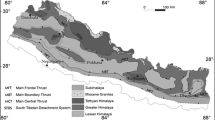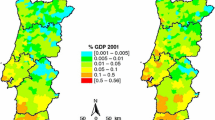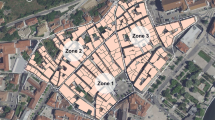Abstract
The identification of the areas with high seismic risk for industrial buildings is of paramount importance for decision-makers to implement risk reduction policies. In this context, this study aims at performing a low-LOD (Level of Detail) code-driven identification of areas in Italy where industrial buildings face high seismic risk. Firstly, the hazard, vulnerability, and exposure models are introduced. Then, such input data are validated by comparing the predictions of the proposed framework with the observational data obtained after the Emilia-Romagna earthquakes of 2012. The validated framework is used to predict the conditional (to a certain return period) and unconditional risk in terms of elements-at-risk and economic losses. The unconditional risk in terms of economic losses expressed in terms of Expected Annual Losses (EAL) is used to rank areas in Italy in terms of seismic risk for industrial buildings. As expected, the area hit by the Emilia-Romagna earthquakes in 2012 is included among those with the highest seismic risk, indicating the predictability of large damage occurred on industrial buildings during the seismic event. Finally, some conclusions are drawn about the implications for future policies and studies for seismic risk reduction of industrial buildings in Italy.

















Similar content being viewed by others
Data availability
The data that support the findings of this study are available from the corresponding author, C.D., upon reasonable request.
References
Aucelli PPC, Di Paola G, Valente E, Amato V, Bracone V, Cesarano M, Di Capua G, Scorpio V, Capalbo A, Pappone G et al (2018) First assessment of the local seismic amplification susceptibility of the Isernia Province (Molise Region, Southern Italy) by the integration of geological and geomorphological studies related to the first level seismic microzonation project. Environ Earth Sci 77(4):118
Babič A, Dolšek M (2016) Seismic fragility functions of industrial precast building classes. Eng Struct 118:357–370
Batalha N, Rodrigues H, Varum H (2019) Seismic performance of RC precast industrial buildings: learning with the past earthquakes. Innov Infrastruct Solut 4(1):4
Beilic D, Casotto C, Nascimbene R, Cicola D, Rodrigues D (2017) Seismic fragility curves of single storey RC precast structures by comparing different Italian codes. Earthq Struct 12(3):359–374
Belleri A, Brunesi E, Nascimbene R, Pagani M, Riva P (2014) Seismic performance of precast industrial facilities following major earthquakes in the Italian territory. J Perform Constr Facil
Bellicoso A (2011) Italian anti-seismic legislation and building restoration. Int J Hous Sci Appl 35(3):137
Bellotti D, Casotto C, Crowley H, Deyanova MG, Germagnoli F, Fianchisti G, Lucarelli E, Riva S, Nascimbene R (2014) Capannoni monopiano prefabbricati: distribuzione proba-bilistica dei sistemi e sottosistemi strutturali dagli anni sessanta ad oggi. Progett Sismica 5(3):41–70
Benfield A (2013) Annual global climate and catastrophe report: 2012. Accessed from 411
Bonfanti C, Carabellese A, Toniolo G (2008) Strutture prefabbricate: catalogo delle tipologie esistenti. ASSOBETON, Milano
Borzi B, Di Capua G (2011) Carta delle tipologie di sottosuolo in base alle categorie delle NTC08 per l’Italia (scala 1:100.000), vincolata a punti di controllo stratigrafici, geotecnici e geofisici, per elaborazioni di pericolosità sismica. Internal report, EUCENTRE-INGV
Braga F, Gigliotti R, Monti G, Morelli F, Nuti C, Salvatore W, Vanzi I (2014) Speedup of post earthquake community recovery: the case of precast industrial buildings after the Emilia 2012 earthquake. Bull Earthq Eng, pp 1–14
Buratti N, Minghini F, Ongaretto E, Savoia M, Tullini N (2017) Empirical seismic fragility for the precast RC industrial buildings damaged by the 2012 Emilia (Italy) earthquakes. Earthq Eng Struct Dyn 46(14):2317–2335
Caputo AC, Kalemi B, Paolacci F, Corritore D (2020) Computing resilience of process plants under Na-Tech events: methodology and application to seismic loading scenarios. Reliab Eng Syst Saf 195:106685
Casotto C, Silva V, Crowley H, Nascimbene R, Pinho R (2015) Seismic fragility of Italian RC precast industrial structures. Eng Struct 94:122–136
Castelli F, Lentini V, Grasso S (2017) Recent developments for the seismic risk assessment. Bull Earthq Eng 15(12):5093–5117
Colombi M, Crowley H, Di Capua G, Peppoloni S, Borzi B, Pinho R, Calvi GM et al (2010) Mappe di rischio sismico a scala nazionale con dati aggiornati sulla pericolosità sismica di base e locale. Progett Sismica
Cornell CA, Jalayer F, Hamburger RO, Foutch DA (2002) Probabilistic basis for 2000 SAC federal emergency management agency steel moment frame guidelines. J Struct Eng 128(4):526–533
Cosenza E, Del Vecchio C, Di Ludovico M, Dolce M, Moroni C, Prota A, Renzi E (2018) The Italian guidelines for seismic risk classification of constructions: technical principles and validation. Bull Earthq Eng 16(12):5905–5935
Crowley H, Colombi M, Borzi B, Faravelli M, Onida M, Lopez M, Polli D, Meroni F, Pinho R (2009) A comparison of seismic risk maps for Italy. Bull Earthq Eng 7(1):149–180
Dassori E, Assobeton (2001) La Prefabbricazione in Calcestruzzo: Guida All’Utilizzo Nella Progettazione, Milano ASSOBETON
Demartino C, Monti G, Vanzi I (2017a) Seismic loss-of-support conditions of frictional beam-to-column connections. Struct Eng Mech 61(4):527–538
Demartino C, Vanzi I, Monti G (2017b) Probabilistic estimation of seismic economic losses of portal-like precast industrial buildings. Earthq Struct 13(3):323–335
Demartino C, Vanzi I, Monti G, Sulpizio C (2018) Precast industrial buildings in Southern Europe: loss of support at frictional beam-to-column connections under seismic actions. Bull Earthq Eng 16(1):259–294
Di Trapani F, Ferro G, Malavisi M (2020) Definition of inelastic displacement demand spectra for precast industrial facilities with friction and fixed beam-to-column joints. Soil Dyn Earthq Eng 128(105):871
Donà M, Bizzaro L, Carturan F, da Porto F (2019) Effects of business recovery strategies on seismic risk and cost-effectiveness of structural retrofitting for business enterprises. Earthq Spectra 35(4):1795–1819
Elenas A, Meskouris K (2001) Correlation study between seismic acceleration parameters and damage indices of structures. Eng Struct 23(6):698–704
Ercolino M, Bellotti D, Magliulo G, Nascimbene R (2018) Vulnerability analysis of industrial RC precast buildings designed according to modern seismic codes. Eng Struct 158:67–78
Eren Ceyhun, Luş Hilmi (2015) A risk based PML estimation method for single-storey reinforced concrete industrial buildings and its impact on earthquake insurance rates. Bull Earthq Eng 13(7):2169–2195
Formisano A, Di Lorenzo G, Landolfo R (2019) Non-linear analyses and fragility curves of European existing single-story steel buildings. In: AIP conference proceedings, vol 2116, no 1, 260020
Frolova NI, Larionov VI, Bonnin J, Sushchev SP, Ugarov AN, Kozlov MA (2017) Seismic risk assessment and mapping at different levels. Nat Hazards 88(1):43–62
Gelman A, Carlin JB, Stern HS, Dunson DB, Vehtari A, Rubin DB (2013) Bayesian data analysis. CRC Press, London
Grünthal G (1998) European macroseismic scale 1998. European Seismological Commission (ESC)
Hofer L, Zanini MA, Faleschini F, Pellegrino C (2018) Profitability analysis for assessing the optimal seismic retrofit strategy of industrial productive processes with business-interruption consequences. J Struct Eng 144(2):04017205
Iervolino I, Chioccarelli E, Convertito V (2011) Engineering design earthquakes from multimodal hazard disaggregation. Soil Dyn Earthq Eng 31:1212–1231. https://doi.org/10.1016/j.soildyn.2011.05.001
ISO, ISO (2009) 31010: Risk management–Risk assessment techniques. Event (London). Geneva 552 (2009)
Kumar Ramesh, Gardoni Paolo (2013) Second-order logarithmic formulation for hazard curves and closed-form approximation to annual failure probability. Struct Saf 45:18–23
Liberatore L, Sorrentino L, Liberatore D, Decanini LD (2013) Failure of industrial structures induced by the Emilia (Italy) 2012 earthquakes. Eng Fail Anal 34:629–647
Maggio F, Lizzi M (2018) The Italian Cadastral System - Edition 2018. Agenzia delle Entrate—Central Directorate for Cadastral, Cartographic and Land Registration Services
Magliulo G, Ercolino M, Petrone C, Coppola O, Manfredi G (2014) The Emilia earthquake: seismic performance of precast reinforced concrete buildings. Earthq Spectra 30(2):891–912
Magliulo G, Bellotti D, Cimmino M, Nascimbene R (2018) Modeling and seismic response analysis of RC precast Italian code-conforming buildings. J Earthq Eng, pp 1–28
Frigerio I, Mugnano S, Mattavelli M, DE AMICIS M (2017) Combining social vulnerability and seismic hazard to produce integrated risk scenarios. In: XXXII Congresso geografico italiano
Meroni F, Squarcina T, Pessina V, Locati M, Modica M, Zoboli R (2017) A damage scenario for the 2012 northern italy earthquakes and estimation of the economic losses to residential buildings. Int J Disaster Risk Sci 8(3):326–341
Michelini A, Faenza L, Lauciani V, Malagnini L (2008) ShakeMap implementation in Italy. Seismol Res Lett 79(5):688–697
MIT (2017) Ministry Decree n.58 28/02/2017 Allegato A: linee guida per la classificazione del rischio sismico delle costruzioni (in Italian).”, Italian Ministry of Infrastructures and Trasport, Italy
MIT (2018) “Ministerial Decree: “NTC 2018 - Norme tecniche per le costruzioni”. (In Italian).”, Ministry of Infrastructures and Transports (Ministero delle Infrastrutture e dei Trasporti)
Oliveira CS, Roca A, Goula X (2008) Assessing and managing earthquake risk: an introduction. in assessing and managing earthquake risk. Springer, Berlin, pp 1–14
Pagliacci F, Russo M (2019) Socioeconomic effects of an earthquake: does spatial heterogeneity matter? Reg Stud 53(4):490–502
Pessina V, Fiorini E (2014) A GIS procedure for fast topographic characterization of seismic recording stations. Soil Dyn Earthq Eng 63:248–258
Rasulo A, Fortuna MA, Borzi B (2016) A seismic risk model for Italy. In: International conference on computational science and its applications, pp 198–213
Region ER (2012) Emilia-romagna regional decree 57/2012. https://www.regione.emilia- romagna.it/terremoto/gli-atti-per-la-ricostruzione/2012/ordinanza-n.-57-del-12-ottobre-2012
Rodrigues D, Crowley H, Silva V (2018) Earthquake loss assessment of precast RC industrial structures in Tuscany (Italy). Bull Earthq Eng 16(1):203–228
Romeo R, Pugliese A (2000) Seismicity, seismotectonics and seismic hazard of Italy. Eng Geol 55(4):241–266
Rossi L, Holtschoppen B, Butenweg C (2019) Official data on the economic consequences of the 2012 Emilia-Romagna earthquake: a first analysis of database SFINGE. Bull Earthq Eng 17(9):4855–4884
Savoia M, Mazzotti C, Buratti N, Ferracuti B, Bovo M, Ligabue V, Vincenzi L (2012) Damages and collapses in industrial precast buildings after the Emilia earthquake. Ing Sismica, pp 2–3
Scozzese F, Terracciano G, Zona A, Della Corte G, Dall’Asta A, Landolfo R (2018) Analysis of seismic non-structural damage in single-storey industrial steel buildings. Soil Dyn Earthq Eng 114:505–519
Senel SM, Kayhan AH (2010) Fragility based damage assesment in existing precast industrial buildings: a case study for Turkey. Struct Eng Mech 11(1):39
Šipoš TK, Hadzima-Nyarko M (2017) Rapid seismic risk assessment. Int J Disaster Risk Reduct 24:348–360
Teramo A, Rafanelli C, Poscolieri M, Castro FL, Iarossi S, Termini D, De Luca M, Marino A, Ruggiano F (2016) Resilience, vulnerability and prevention policies of territorial systems in areas at high seismic risk. In: Earthquakes and their impact on society. Springer, Berlin, pp 323–344
Tucker BE, Erdik MÖ, Hwang CN (2013) Issues in urban earthquake risk vol 271. Springer, Berlin
Vanzi I, Marano GC, Monti G, Nuti C (2015) A synthetic formulation for the Italian seismic hazard and code implications for the seismic risk. Soil Dyn Earthq Eng 77:111–122
Vela RJM, Brunesi E, Nascimbene R (2019) Seismic assessment of an industrial frame-tank system: development of fragility functions. Bull Earthq Eng 17(5):2569–2602
Vona M, Mastroberti M, Amato F (2017) Hierarchical spatial distribution of seismic risk of Italian RC buildings stock. In: international conference on computational science and its applications, pp 217–229
Worden C, Wald DJ (2016) ShakeMap manual online: technical manual, user’s guide, and software guide. https://doi.org/10.1234/012345678
Xiong C, Lu X, Huang J, Guan H (2018) Multi-LOD seismic-damage simulation of urban buildings and case study in Beijing CBD. Bull Earthq Eng, pp 1–21
Zanini MA, Hofer L, Pellegrino C (2019) A framework for assessing the seismic risk map of Italy and developing a sustainable risk reduction program. Int J Disaster Risk Reduct 33:74–93
Acknowledgements
DPC-ReLUIS 2019-2021 project is acknowledged for the financial support given to the present research. Authors are grateful to “Agenzia delle Entrate” (Italian Tax Revenue Agency) for providing data analyzed in this study. The first author is acknowledging the Zhejiang University–University of Illinois at Urbana Champaign Institute (ZJUI) for the financial support given to the present research.
Author information
Authors and Affiliations
Corresponding author
Additional information
Publisher's Note
Springer Nature remains neutral with regard to jurisdictional claims in published maps and institutional affiliations.
Appendix A: Exposure models not employed
Appendix A: Exposure models not employed
1.1 A1 Industrial districts
Starting from the Local Labor Systems (Sistemi Locali del Lavoro—SLL), on the basis of the analysis of their production specialization, ISTAT (Italian National Institute of Statistics) has identified 141 industrial districts using the data of the economic units surveyed in 2011 through the 9th General Census of industry and services. Italian industrial district in 2011 from ISTAT are depicted in Fig. 18.
1.2 A2 Corine land cover
The CORINE Land Cover (CLC) is a vector map with a scale of 1:100 000, a minimum cartographic unit of 0.25 km2. CLC database is based on the visual interpretation that is a method of recognizing, identifying and assessing of objects recorded in areal or satellite images. CLC database contains a computerized inventory on land cover of the 27 EC member states and other European countries using 44 classes of the 3-level Corine nomenclature. Industrial buildings are considered located in areas with CLC class level 1.2 (Artificial areas—Industrial, commercial and transport units) that is defined as “Areas mainly occupied by industrial activities of manufacturing, trade, financial activities and services, transport infrastructures for road traffic and rail networks, airport installations, river and sea port installations, including their associated lands and access infrastructures. Includes industrial livestock rearing facilities”. The areas where the industrial buildings are located according to CLC are reported in Fig. 19.
1.3 A3 OpenStreet Map
OpenStreetMap (OSM) is a collaborative project to create a free editable map of the world and is probably the best known example of volunteered geographic information. OSM represents physical features on the ground (e.g., roads or buildings) using tags attached to its basic data structures (its nodes, ways, and relations). Each tag describes a geographic attribute of the feature being shown by that specific node, way or relation. In particular, the industrial buildings are categorized as with the key “building” and the value “industrial” that is defined as “A building where some industrial process takes place”. Use warehouse if the purpose is known to be primarily for storage/distribution”. The so-derived distribution of the industrial buildings according to OSM is reported in Fig. 20.
Rights and permissions
About this article
Cite this article
Demartino, C., Monti, G. Low-LOD code-driven identification of the high seismic risk areas for industrial buildings in Italy. Bull Earthquake Eng 18, 4421–4452 (2020). https://doi.org/10.1007/s10518-020-00867-3
Received:
Accepted:
Published:
Issue Date:
DOI: https://doi.org/10.1007/s10518-020-00867-3







